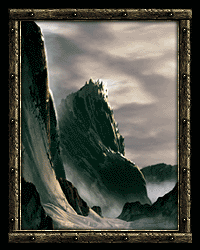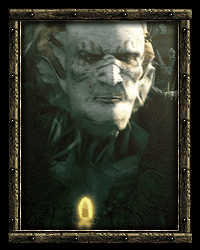 "Ice Caves" - Liner Notes - June 4, 2002
"Ice Caves" - Liner Notes - June 4, 2002
Though I was hoping for a combination of some of my favorite moments from Bernard Herrmann's "Vertigo" and a sequence in Orff's "Trionfo di Afrodite" with this one, I ended up with a rather frustrating product which really didn't work as well as either of my two models. The jarring breaks between the hypnotic harp ostinato and the brass hits succeeded more in breaking a consistent mood than creating one. If I were to step back into the time machine and rewrite this one, I would try to keep the pacing away from the extremes used here, and would have also used a bit more of the electronic and choral textures which I consciously avoided in these sessions. What remains after too much editing only goes half of the way there - a bit of a shame seeing as how interesting an enviroment like "ice caves" should be.
- Matt Uelmen
 "Halls" - Liner Notes - May 31, 2002
"Halls" - Liner Notes - May 31, 2002
If one were to break down the structure of the levels of Diablo 2 into a flowchart, you would make the surprising discovery that some areas,
often including some excellent unique background art, are able to be ignored without impeding completion of the act. Though it might
seem strange to "waste" perfectly good content, I have always like the idea that the player can either choose to rampage through the
level or can opt for the scenic route, letting no miniboss escape their wrath. On my end, this structure creates a different set of
demands from pieces located in different places in the structure of the act. Tunes like this one, featured in a "sidequest", have
much more freedom to explore different musical elements than music which the player will face inevitably and repeatedly, like the
songs featured in the town or opening fight sequence. I attempted to take advantage of this freedom with this track, pushing the
elements of the horror soundtrack - clusters, atonality, glissandi, sudden hits - as much as possible. I was quite happy with the
way this worked in the game, and felt it did the job as a backdrop to the nefarious plans of Nihlathak.
- Matt Uelmen
 |
| An ambient shot of central Europe captured by Scott Petersen. |
Earlier this year, a composer and crew from Blizzard North went to Bratislava, Slovakia to record the Diablo II: Lord of Destruction score with the Slovak Radio Philharmonic. Kirk Trevor of the Knoxville Symphony Orchestra conducted and "Ancients" is one of the tracks that resulted from these sessions.
"Ancients" - Liner Notes - October 1, 2001
This track, heard in the final showdown with Baal, is in many ways the omega
to the alpha that was the original Diablo® theme. Most of this track is
structured around the core motives heard throughout the Diablo series,
fleshed out in as bombastic as way as possible. The transformation from the
gentle but menacing guitar and flute of the original Tristram is now
complete, though the melodic structure still remains. During a pleasant
lunch at the cafe in the Slovak Radio building, Maestro Kirk Trevor related
how he had spent his early teenage years immersed in the world of Wagner's
Ring. Perhaps because of the familiarity of these Wagnerian textures to the
Maestro and the players, this track was easily the most pleasant and
quickest to record of all of the tunes that week. Though Tolkein is the
more obvious and common reference for the fantasy genre, I find
Der Ring der Nibelungen to be the final word in the genre which Diablo and other
sword-and-sorcery titles inhabit. Siegfrieds Tod is either used directly or
strongly referenced in films like Excalibur and Gladiator for good reason -
nothing captures the struggles of mortals amongst gods quite like the
original recipe.
 Matt Uelmen watches as the score in his hands comes to life on stage.
Matt Uelmen watches as the score in his hands comes to life on stage. |
Liner Notes by Matt Uelmen,
Score Composer / Blizzard North:
|
 |
| Matt Uelmen in the control room with Emil Niznansky and Hubert Geschwandter at the board. |
Earlier this year, a composer and crew from Blizzard North went to Bratislava, Slovakia to record the Diablo II: Lord of Destruction score with the Slovak Radio Philharmonic. Kirk Trevor of the Knoxville Symphony Orchestra conducted and "Siege" is one of the tracks that resulted from these sessions.
"Siege" - Liner Notes - September 19, 2001
"This roots of this piece go back to a tune dubbed "March of the
Sparkies" in the hazy, distant days of 1995, when the first musical
sketches for Diablo were being written. I was attempting to get the
sound of a big orchestral march from a somewhat skimpy library of samples
without much of a result. Though I stubbornly refused to give up in my
quest to get the proper sound, ending up with a decent march as the
opening theme for the original Diablo (and a not-quite-so-decent leftover
used in "Hellfire"), it was not until this was recorded in February 2001
that I felt I had realized the proper formula. Of course, having the
help of ninety or so skilled musicians often helps in situations like these.
This one was an absolute bear to record, largely due to my amateur
notation of time values and a high violin part, but it ended up being
the single track which I am most proud of from the sessions recorded in
Bratislava. I felt like I was employing every other musician in
Slovakia on the day of this recording, as we called for an extra set of
percussionists to handle the snare part, which I insisted needed to be
at least tripled. Though classic marches like Ravel's "Bolero" or Holst's
"Mars" call for only one snare drum, I was aiming for the more Hollywood
drum chorus effect, best shown in soundtrack patriarch Alfred Newman's
original Fox theme."
 |
| Ninety of Slovakia's finest do what they do best. |
Liner Notes by Matt Uelmen,
Score Composer / Blizzard North:
Download "Siege"(6:48):
Download Site [6.38 MB]
Estimated Download Time for 28.8 kbps data transfer: 30 minutes.
In order to listen to a sample in MP3 format, you will need an
MP3 Player.